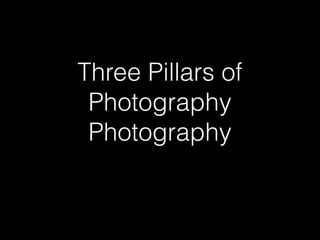Report
Share

Recommended
More Related Content
What's hot
What's hot (20)
Viewers also liked
Viewers also liked (6)
Different styles and types of photography for record

Different styles and types of photography for record
Similar to Photo shutter speed
Similar to Photo shutter speed (20)
Basic DSLR Photography and Videography for AITians

Basic DSLR Photography and Videography for AITians
More from micahkraus
More from micahkraus (20)
Photo shutter speed
- 1. Three Pillars of Photography Photography
- 2. Three Pillars of Photography • Aperture • Shutter Speed • ISO (film speed)
- 3. Shutter Speed • What is a Shutter? • The shutter is a curtain that covers the camera sensor until the shutter button is pressed. When it moves, light is allowed to hit the sensor to create an image.
- 5. Shutter Speed Defined • Shutter Speed refers to the length of time the camera sensor is exposed to light. It is the length of time the camera shutter is held open. • Shutter speeds range from 1/2000 of a second (pretty darn fast) to 1 second and longer.
- 6. Effects of Shutter • Speed A fast or quick shutter speed freezes motion and can be used in situations with a lot of light. Because the shutter open for a very short period of time a lot of light is required for a proper exposure. • A slow or long shutter speed (anything longer than 1/60 of a second) will allow more light to enter the camera and causes motion blur. • A slow or long exposure requires the use of a tripod or stabilizing method in order to make the blur localized to only the moving element.
- 7. This photo was taken at 1/1600 second
- 8. This photo was taken at 1/250 second
- 9. This photo was taken at 1/2 second
- 10. This photo was taken at 5 seconds
- 11. Shutter Speed and Aperture • A fast shutter speed requires more light to create a proper exposure. • How does this impact your aperture setting? • If you use a fast shutter speed you need to have a large aperture. • A slower shutter speed needs less light and therefore a smaller aperture.
- 12. Shutter Speed, Aperture and Depth of • The depth of field of a photograph becomes Field shallower when the aperture is larger (smaller f-stop number). • To take photographs with a shallow depth of field you typically need a large f-stop (f1.7 - f2.5) and a fast shutter speed (1/250 - 1/2000 second) • If there is a lot of light the camera will want to "stop down" or decrease the size of the aperture which will result in more of the image being in focus.
- 13. The image on the left used a large aperture (f1/7) and a fast shutter speed (1/800 second). The image on the right used a smaller aperture (f14) and and a slower shutter speed (1/100 second).
- 14. You've just learned about shutter, shutter speed, motion blur, and how shutter speed and aperture interact to impact depth of field.